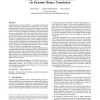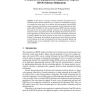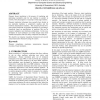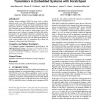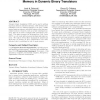VEE
2012
ACM
12 years 11 months ago
2012
ACM
Process-level virtualization is increasingly being used to enhance the security of software applications from reverse engineering and unauthorized modification (called software p...
ASPLOS
2012
ACM
12 years 12 months ago
2012
ACM
Dynamic binary translation (DBT) is a powerful technique that enables fine-grained monitoring and manipulation of an existing program binary. At the user level, it has been emplo...
IFIP
2010
Springer
13 years 11 months ago
2010
Springer
Abstract. In this article, we present a flexible simulation environment for embedded real-time software refinement by a mixed level cosimulation. For this, ne the native speed of a...
DYNAMO
2000
14 years 5 months ago
2000
Dynamic binary translation is the process of translating and optimizing executable code for one machine to another at runtime, while the program is "executing" on the ta...
CASES
2007
ACM
14 years 8 months ago
2007
ACM
Dynamic binary translation (DBT) has been used to achieve numerous goals (e.g., better performance) for general-purpose computers. Recently, DBT has also attracted attention for e...
SIGMETRICS
1996
ACM
14 years 8 months ago
1996
ACM
This paper describes Embra, a simulator for the processors, caches, and memory systems of uniprocessors and cache-coherent multiprocessors. When running as part of the SimOS simul...
DAC
2009
ACM
14 years 9 months ago
2009
ACM
Dynamic binary translation (DBT) can be used to address important issues in embedded systems. DBT systems store translated code in a software-managed code cache. Unlike general-pu...
CGO
2003
IEEE
14 years 9 months ago
2003
IEEE
A dynamic binary translation system for a co-designed virtual machine is described and evaluated. The underlying hardware directly executes an accumulator-oriented instruction set...
LCTRTS
2009
Springer
14 years 11 months ago
2009
Springer
Dynamic binary translation (DBT) can provide security, virtualization, resource management and other desirable services to embedded systems. Although DBT has many benefits, its r...

